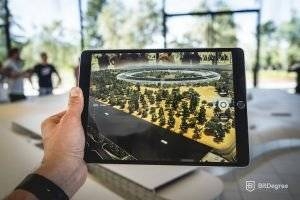Stop overpaying - start transferring money with Ogvio. Sign up, invite friends & grab Rewards now! 🎁
When the current reality is not enough anymore to make ideas come to life, technology offers a solution. What previously was thought to be only possible in fictional movies, nowadays seems to be a typical everyday thing. The digital revolution continues its reign and gave birth to one of the cutting-edge technologies - augmented reality. Many scientists from the past imagined what is augmented reality and what it could be but only recent technological advances enabled the opportunity of making it real.
Augmented reality is a technology that expands the current boundaries of the real world. It adds any kind of wanted digital layers to the reality we know, and can make it gamified or extraordinary in any kind of way. What is important to know is that augmented reality is a different thing from the virtual reality you may hear of. Virtual reality is something that replaces the reality, while, as mentioned previously, AR only expands it but does not replace it. Augmented reality apps can add sounds, views, elements, or graphics.
The proper definition of augmented reality would be - a view of a physical real-world environment with superimposed computer-generated images that change the perception of reality. But when did this idea begin?
Table of Contents
Brief History of AR
While the main term of what is augmented reality formed back in 1990, its history goes beyond that. One of the very first creations of AR was built in the 1960s. It was a quite primitive device called “The Sword of Damocles” that offered nothing more than poor graphics and an inconvenient headset.
Latest DataCamp Coupon Found:A decade later, an artificial reality library was created, when a visionary scientist imagined how people will start to interact with digital devices. This vision of Myron Krueger was later on used for video cameras, displaying silhouettes on screens, and projectors.

Although it is hard to believe how advanced scientists were in 1980, Steve Mann created the “EyeTap”, which was made to be worn as portable computer glasses in front of the eyes. The goal behind this technology was to add effects to what the wearer sees via head movement. In 1987, a couple of scientists improved this device and created a heads-up display (HUD), that could display astronomical data while looking at the real sky.
Coming into the 1990s, the term of what is augmented reality was invented. One of the very first mentions of it was in television commercials, military, navigation systems, and Boeing company researchers' notes.
Coming into the 21st century, augmented reality only proceeded to get even more modern. In the early 2000s, the AR tool kit was developed by a Japanese scientist and later on Trimble Navigation presented an outdoor helmet-mounted AR system. In the upcoming years, AR apps accelerated, even more, when the “Google Glass” was launched and the world was introduced to the application that blew away the gaming industry - Pokemon GO.
How Does Augmented Reality Work?
 Augmented reality is the process of blending interactive digital elements with real-world environment details. Pokemon GO can be a perfect example of how AR works. You walk around with your smartphone and the device captures surroundings and enhances it with a lot of visuals, icons, characters, and other miscellaneous elements. On the other hand, smartphones are not the only devices that can be used to understand what is augmented reality. Simultaneous localization and mapping, depth tracking and other components can be found in such technologies as glasses, handheld devices, head-mounted displays or screens.
Augmented reality is the process of blending interactive digital elements with real-world environment details. Pokemon GO can be a perfect example of how AR works. You walk around with your smartphone and the device captures surroundings and enhances it with a lot of visuals, icons, characters, and other miscellaneous elements. On the other hand, smartphones are not the only devices that can be used to understand what is augmented reality. Simultaneous localization and mapping, depth tracking and other components can be found in such technologies as glasses, handheld devices, head-mounted displays or screens.
Some of the most important components of augmented reality are:
- Cameras and sensors. One of the key parts of a successful augmented reality performance is cameras and sensors. These devices are used to collect data from the surroundings and then to process it into the application. Using cameras, AR devices scan the objects in front of them, physically locate and measure objects and enhance them with 3D models of AR. The range for cameras and sensors goes wide but it still needs to be advanced as modern smartphones are now.
- Processing. As mentioned in the bullet-point above, it is important not only to capture the surroundings but also to process them. One of the most important things in understanding what is augmented reality is to understand how the real-life images are changed into augmented ones. To make this happen, the device that holds AR apps has to have certain specifications. Other than that, a CPU, a GPU, RAM, a GPS, internet connection, Bluetooth, flash memory, etc. These specs help the AR applications in the device to orientate in space and to better understand the reality surrounding it.
- Projection. This implies more on the headsets. The projection turns any surface into an augmented reality interactive environment. Mostly, it changes the view just in front of the user. The surface for the projection does not have much impact, it can be anything - a wall, a hand, the floor, etc.
- Reflection. In augmented reality devices or applications, reflections help to path the graphically changed images to the user's eye to view it. AR devices use small curved, double-side mirrors to reflect the incoming light to a side-mounted camera. A so-called light-engine in the augmented reality devices emits the light towards two separate lenses for each eye, which consists of three layers of glass of three primary RBG colors.
The Different Types of AR
 These technological elements are the only things that add-up into what is augmented reality term. The process of it is a complex of different technologies, and it can work through different approaches.
These technological elements are the only things that add-up into what is augmented reality term. The process of it is a complex of different technologies, and it can work through different approaches.
- SLAM. As it was mentioned slightly above in the text, simultaneous localization and mapping are some of the most effective ways to render augmented real-life images. This technology localizes sensors by taking into account the surroundings and proceeds to map the structure of the environment. It is a set of algorithms that work exactly on what is mentioned in the acronym itself. Every augmented reality development kit provides SLAM functionality.
- Recognition. This technology is based on the usage of the camera to identify visual markers or objects. They cant be 2D, QR codes or natural feature tracking markers (NFT), which shows an overlay when the marker is covered by the device’s camera. The marker-based AR technology mostly depends on the camera to distinguish a marker from the real-world objects. When the marker is recognized by the device, it is immediately replaced by the virtual 3D graphics.
- Location-Based. Opposite to what is augmented reality by recognition, location-based AR is mainly based on a GPS, digital compass, velocity meter, or accelerator to receive the data about the location and implement augmented reality visual based on the data that is collected. Smartphones are one of the best possible devices to use location-based AR apps since they have the needed functions and make it easy to leverage this type of technology, at the same time making it even more popular. If you are wondering if you ever met this kind of technology - you probably have. It is mostly used in such technologies as finding nearby services, location-centric mobile apps, and mapping directions.
Augmented Reality Devices
 Nowadays it would be quite hard to find devices that do not support the technology of AR. While smartphones are the most popular devices for this niche, tablets, handheld devices and gadgets like Google Glass are only the beginning of what is an augmented reality about to evolve into shortly. What are the current devices that are capable of handling augmented reality and what are their categories?
Nowadays it would be quite hard to find devices that do not support the technology of AR. While smartphones are the most popular devices for this niche, tablets, handheld devices and gadgets like Google Glass are only the beginning of what is an augmented reality about to evolve into shortly. What are the current devices that are capable of handling augmented reality and what are their categories?
- Mobile devices. We already talked a lot about how smartphones and tablets have benefited the market of augmented reality. Mobile AR apps perform best for gaming, entertainment, business, analytics, sports, and social networking purposes.
- Special AR devices. These technological appliances are solely designed only for augmented reality experiences. One example of this can be the head-up displays (HUDs), that send data to a transparent display directly into the user’s view. The HUD was at first mainly used to train aviation and military pilots and now these appliances are used in the automotive, manufacturing, sports, and many more industries.
- AR glasses. Besides the famous Google Glass, there are many more devices that are capable of acting on similar functions. Laforge AR eyewear, Meta 2 Glasses, Lester See-Thru, and others are capable of displaying notifications from the smartphones, accessing to hands-free information, assisting many workers in the manufacturing industry, giving quick access to the internet depending on the device you use.
- AR contact lenses. Although this technology is still far away from being realized, the new research is paving its way and could be the thing that changes what is augmented reality or takes it to another level. Some of the biggest manufacturers in the world announced the creation of this digital appliance. The AR contact lenses will be an addition to our current smartphones, or it will be an appliance that will be capable of running on its own and performing actions like cameras.

Did you know?
Have you ever wondered which online learning platforms are the best for your career?
Moving Forward
 The technology behind augmented reality is still currently in development and adds a step forward every day. Many technology experts predict that AR will only be increasing in popularity because of its efficiency in making daily people’s or worker’s tasks easier. Augmented reality is becoming a thing that will be able to solve almost every issue and be applied in most, if not all, of the industries around the world.
The technology behind augmented reality is still currently in development and adds a step forward every day. Many technology experts predict that AR will only be increasing in popularity because of its efficiency in making daily people’s or worker’s tasks easier. Augmented reality is becoming a thing that will be able to solve almost every issue and be applied in most, if not all, of the industries around the world.
AR apps in gaming have already shown a small part of the potential of what is augmented reality technology capable of. It is only a matter of time until the true potential of these appliances will be unveiled in education, medicine, art, tourism, and all remaining industries.











